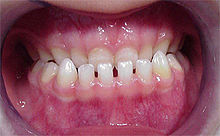Progeny
Progeny describes a jaw misalignment ( dysgnathia ), which is characterized by a reversed overbite of the incisors (frontal crossbite ) as a leading symptom. The frontal crossbite is usually caused by a disproportion in the positional relationship of the upper jaw to the lower jaw (pure misalignments of the upper and lower incisors must also be taken into account). A distinction is made between the real progeny , characterized by an overdevelopment of the lower jaw, from the false progeny , which is characterized by an underdevelopment of the upper jaw / midface. Combinations of both forms can also occur.
The term progeny is out of date and misleading as it simply describes the symptom of 'protruding chin'. Technically correct, these are dysgnathias of the progene form, which in turn are subdivided. The mandibular prognathy is called true prognathy and the maxillary retrognathy is called spurious or pseudo- prognathic .
causes
The triggers are mostly multifactorial. Inheritance ( genetics ), however, plays a major role, since progeny is inherited dominantly. But functional disorders such as tongue malfunctions (dyskinesia) or morphological deviations such as an enlarged tongue, impaired nasal breathing and the associated mouth breathing can lead to a lack of developmental stimuli for the growth of the upper jaw. Cleft lip and palate form a special case, which, due to the scarring, lead to growth inhibition in the upper jaw.
The pictures on the right show an inherited (hereditary) progeny in a family. The father inherited the dysgnathia dominantly to the daughter (4 years old in the picture).
The progeny is - next to the so-called Habsburg lip - one of the characteristics of the " Habsburg face type" depicted in portraits such as the one of Charles II .
Appearance

While a protruding chin and a protruding lower jaw with a strong lower lip (positive lip staircase) can be seen in the real progeny , the fake progeny is characterized by a flattened middle face and a sunken upper lip. In the mouth, the progeny is often characterized by a narrow upper jaw and a wide lower jaw. In the upper jaw there is a pronounced lack of space, while in the lower jaw gaps can sometimes be observed due to an excess of space. The tongue resting position is mostly down and forward in the affected persons. Often they also show mouth breathing. The so-called mesial bite appears in the occlusion . It is not uncommon to find not only a reverse frontal overbite, but a complete encirclement of the upper jaw by the lower jaw. In an X-ray overview ( orthopantomogram ) of the teeth, the narrow germ layer in the upper jaw and the wide germ layer in the lower jaw, especially in the area of the 2nd premolar and wisdom tooth germs, are noticeable. The lateral cephalometric image of the skull impressively shows the misrelationship between the upper and lower jaw bases as well as the possible incisor misalignment.
treatment
Starting treatment early promotes the success of orthodontic therapy. Careful diagnosis is essential for the choice of treatment device. Treatment tasks include developing the base of the upper jaw, eliminating the lack of space, holding the lower jaw, transferring the crossbite frontally and laterally, achieving neutral teeth in the posterior region and setting the correct position of the anterior teeth. Removable or fixed appliances (multi-bracket systems) are used. The use of the function regulator according to Fränkel (FR III) has proven itself when starting treatment early . When using the reversed headgear according to Delaire ("Delaire mask"), the combination with a palatal expansion device is often used for strong transverse stretching of the upper jaw. Orthodontists who have a holistic therapeutic approach usually do without treatment devices such as the Delaire mask or the palatal expansion device, which require the use of strong forces.
The orthodontic treatment must take place beyond the pubertal growth maximum in order to avoid uncontrolled growth and to achieve a long-term stable occlusion that conforms to standards.
If the growth cannot be sufficiently influenced by orthodontics, a combined treatment in cooperation with orthodontics and oral surgery may be necessary after the growth is complete (approx. 18 years of age) .

